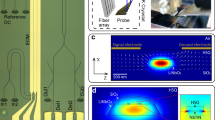Abstract
Anisotropy photoresponse can be effectively achieved based on gradient organic heterojunction. However, the gradient heterojunction has yet been studied due to the complicated process and great random error inside. Especially in the field of transient optics, the light on/off in femto/picosecond range is vitally important for high-speed optical systems, such as application in fiber communications. In this paper, the wedge-structured organic heterojunction was fabricated based on molecular beam epitaxy. The devices were combined with both wedge-structured heterojunction and half-wave plate. When the probe light was tuned to 2.0 eV, a narrow passband was instantly observed once the pump and probe light were perpendicular to each other. The photoresponse can be achieved within 0.84 ps which can tune the optical signals on and off in transient optics. The results have demonstrated an exciting application in photo sensing.






Similar content being viewed by others
References
Han P, Zhang XQ, Yang H et al (2018) Thienoisoindigo-based polymers bearing diethynylbenzene and diethynylanthracene units for thin film transistors and solar cells. J Nanosci Nanotechnol 18(8):5534–5541
Pandey R, Lim JW, Choi WK et al (2018) Performance enhancement in oranic photovoltaic solar cells using iridium (Ir) ultra-thin surface modifier (USM). Appl Surf Sci 444:97–104
Oseni SO, Kaviyarasu K, Mola GT et al (2018) ZnO:CNT assisted charge transport in PTB7:PCBM blend organic solar cell. J Alloys Compd 748:216–222
Jung E, Ahn H, Jo WH et al (2019) Isoindigo-based conjugated polymer for high-performance organic solar cell with a high V-OC of 1.06 V as processed from non-halogenated solvent. Dyes Pigments 161:113–118
Chen J, Li B, Ren XJ et al (2019) Highly twisted ladder-type backbone bearing perylene diimides for non-fullerene acceptors in organic solar cells. Dyes Pigments 161:221–226
Wang Y, Liu P, Wang H et al (2019) Flexible organic light-emitting devices with copper nanowire composite transparent conductive electrode. J Mater Sci 54(3):2343–2350
Lee CJ, Choi PB et al (2018) Investigation of the charge balance in green phosphorescent organic light-emitting diodes by controlling the mixed host emission layer. J Nanosci Nanotechnol 18(9):5908–5912
Kang J, Kim C, Seung S et al (2018) Efficient organic light-emitting diodes based on naphthoanthracene derivatives. J Nanosci Nanotechnol 18(9):6021–6025
Liu SJ, Guan M, Zeng YP et al (2018) The charge confinement effect of quantum-well Alq(3)-based OLEDs by dual-pulsed transient electroluminescence. Opt Commun 419:13–17
Kang J, Kim CM, Hwang NH et al (2019) Highly efficient organic light-emitting diodes based on naphthoanthracene derivatives containing different arylamines. J Nanosci Nanotechnol 19(3):1393–1398
Ahamd H, Aidi SN, Tiu ZC et al (2018) Tunable passively Q-switched erbium-doped fiber laser with chitosan/MoS2 saturable absorber. Opt Laser Technol 103:199–205
Gandhimathi A, Karunakaran RT, Pranajar S et al (2018) Spectroscopic and quantum chemical perspectives on 2-amino 5-methylpyridinium 4-nitrobenzoate - an organic single crystal for optoelectronics device applications. Opt Laser Technol 103:291–299
Liu WY, Li BN, Gao H et al (2019) The application of small organic pi-conjugated discotic derivatives in photoacoustic imaging and photothermal conversion. Nanotechnology 30(3):035705
Jasper HM, Smit JH, Hebisch E et al (2019) Self-healing dyes for super-resolution fluorescence microscopy. J Phys D Appl Phys 52(3):034001
Chen J, Tao X, Tao L et al (2019) Novel conjugated organic polymers as candidates for visible-light-driven photocatalytic hydrogen production. Appl Catal B Environ 241:461–470
Mica NA, Thomson SAJ, Samuel DW (2018) Electron mobility of non-fullerene acceptors using a time of flight method. Org Electron 63:415–420
Upama MB, Elumalai NK, Mahmud MA et al (2018) Enhanced electron transport enables over 12% efficiency by interface engineering of non-fullerene organic solar cells. Sol Energy Mater Sol Cells 187:273–282
Lee C, Kim J, Moon Y et al (2018) Organic phototransistors with bulk heterojunction sensing-channel layers containing soluble difluorinated diketopyrrolopyrrole acceptor. Dyes Pigments 156:219–224
Liu GL, Guo Y, Li GH et al (2016) Enhanced PEDOT: PSS films by acetonitrile co-solvents and their application on polymer solar cells. Optoelectron Adv Mater Rapid Commun 10(9–10):693–699
Guo Y, Zhu HX, Li GH et al (2016) Polymer solar cells with high open-circuit voltage based on novel barbell-shaped bifullerene derivative as acceptor. Chin J Org Chem 36(1):172–178
Liu GL, Guo Y, Li GH et al (2015) Shielded gas annealing: the improvement of optical-electric properties in the PEDOT: PSS layer of polymer solar cells. Optoelectron Adv Mater Rapid Commun 9(11–12):1448–1452
Liu GL, Guo Y, Li GH et al (2015) Investigation on polymer solar cells by using calcium as an electron transportation layer. Physica A 436:286–292
Xi X, Chen XJ, Li GH et al (2015) The optimizing of thickness combination in organic solar cells with the concept of effective exciton generation rate. Optoelectron Adv Mater Rapid Commun 9(5–6):646–652
Xi X, Li WJ, Li GH et al (2010) A comparative study on the performances of small molecule organic solar cells based on CuPc/C-60 and CuPc/C-70. Sol Energy Mater Sol Cells 94(12):2435–2441
Cabanillas JC, Rodriguez OP, Quiles MC et al (2011) Organic position sensitive phododetectors based on lateral donor-acceptor concentration gradients. Appl Phys Lett 99:103305
Liu G, Chen M, Xi X et al (2018) Investigation and application of the optical field distribution in gradient organic heterojunction. Opt Commun 429:60–64
Funding
The project is supported by Natural Science Foundation of the Higher Education Institutions of Jiangsu Province, China (Grant Nos. BK20180601 and BK20180596), the Fundamental Research Funds for the Central Universities (Grant Nos. JUSRP11834, JUSRP21935 and JUSRP11834B), and the Jiangsu Postdoctoral Science Foundation (Grant Nos. 2018K112C and 2018K113C).
Author information
Authors and Affiliations
Corresponding author
Additional information
Publisher’s Note
Springer Nature remains neutral with regard to jurisdictional claims in published maps and institutional affiliations.
Rights and permissions
About this article
Cite this article
Liu, G., Zhang, Z., Shao, J. et al. The Application of the Transient Optical Switch Based on Gradient Organic Heterojunctions. Plasmonics 14, 1405–1410 (2019). https://doi.org/10.1007/s11468-019-00924-x
Received:
Accepted:
Published:
Issue Date:
DOI: https://doi.org/10.1007/s11468-019-00924-x




